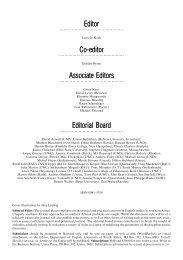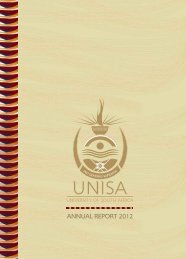Download the Annual report 2011 - Unisa
Download the Annual report 2011 - Unisa
Download the Annual report 2011 - Unisa
Create successful ePaper yourself
Turn your PDF publications into a flip-book with our unique Google optimized e-Paper software.
UNISA ANNUAL REPORT <strong>2011</strong><br />
Costs associated with maintaining computer software programmes are capitalised as intangible assets only if<br />
<strong>the</strong>y qualify for recognition. In all o<strong>the</strong>r cases, <strong>the</strong>se costs are recognised as an expense as incurred.<br />
Costs that are directly associated with <strong>the</strong> development and production of identifiable and unique software<br />
products controlled by <strong>the</strong> University and that will probably generate economic benefits exceeding one year<br />
are recognised as intangible assets. Direct costs include <strong>the</strong> costs of software development, employees’ costs<br />
and an appropriate allocation of relevant overheads.<br />
Computer software is amortised on a straight-line basis over its estimated useful life from <strong>the</strong> date it becomes<br />
available for use.<br />
The current useful life is:<br />
• Capitalised software - 3 years (2010 – 3 years)<br />
Subsequent expenditure on capitalised intangible assets is capitalised when it increases <strong>the</strong> future economic<br />
benefits embodied in <strong>the</strong> specific asset to which it relates and <strong>the</strong> costs can be measured reliably. All o<strong>the</strong>r<br />
expenditure is expensed as incurred.<br />
2.8 IMPAIRMENT OF FINANCIAL AND NON-FINANCIAL ASSETS<br />
The carrying amounts of <strong>the</strong> University’s assets o<strong>the</strong>r than inventories are reviewed at each <strong>report</strong>ing date to<br />
determine whe<strong>the</strong>r <strong>the</strong>re is any indication of impairment. If <strong>the</strong>re is any indication that an asset may be impaired,<br />
its recoverable amount is estimated.<br />
The allowance accounts in respect of student and o<strong>the</strong>r receivables are used to record impairment losses unless<br />
<strong>the</strong> University is satisfied that no recovery of <strong>the</strong> amount owing is possible. At that point <strong>the</strong> amounts<br />
considered irrecoverable are written off directly against <strong>the</strong> financial asset.<br />
The impairment of student receivables, loans and o<strong>the</strong>r receivables is established when <strong>the</strong>re is objective evidence<br />
that <strong>the</strong> University will not be able to collect all amounts due in accordance with <strong>the</strong> original terms of <strong>the</strong><br />
credit/loans given, and includes an assessment of recoverability based on historical trend analyses and events<br />
that exist at <strong>the</strong> <strong>report</strong>ing date. In assessing collective impairment <strong>the</strong> University uses historical trends of <strong>the</strong><br />
probability of default, <strong>the</strong> timing of recoveries and <strong>the</strong> amount of loss incurred, adjusted for management’s<br />
judgement. The amount of <strong>the</strong> impairment adjustment is <strong>the</strong> difference between <strong>the</strong> carrying value and <strong>the</strong><br />
present value. For debtors, impairment losses are recognised in profit or loss.<br />
For loans and receivables <strong>the</strong> adjustment is established when <strong>the</strong>re is objective evidence that <strong>the</strong> University<br />
will not be able to collect all amounts due according to <strong>the</strong> original terms of <strong>the</strong> loan or receivable. Objective<br />
evidence included default of delinquency by a debtor or adverse changes in <strong>the</strong> payment status of debtors to<br />
<strong>the</strong> University.<br />
An impairment loss is recognised if <strong>the</strong> carrying amount of a non-financial asset or its cash-generating unit<br />
exceeds its recoverable amount. A cash-generating unit is <strong>the</strong> smallest identifiable asset group that generates<br />
cash flows that are largely independent from o<strong>the</strong>r assets and groups.<br />
Impairment losses are recognised in profit or loss. Impairment losses recognised in respect of cash-generating<br />
units are allocated to reduce <strong>the</strong> carrying amount of <strong>the</strong> o<strong>the</strong>r assets in <strong>the</strong> unit (group of units) on a pro rata<br />
basis.<br />
2.8.1 Calculation of recoverable amount<br />
The recoverable amount of <strong>the</strong> University’s investments in receivables carried at amortised cost is calculated as<br />
<strong>the</strong> present value of estimated future cash flows, discounted at <strong>the</strong> original effective interest rate (<strong>the</strong> effective<br />
interest rate computed at initial recognition of <strong>the</strong>se financial assets). Receivables with a short duration are<br />
not discounted.<br />
The recoverable amount of non-financial assets is <strong>the</strong> greater of <strong>the</strong>ir value in use and its fair value less cost<br />
to sell. In assessing value in use, <strong>the</strong> estimated future cash flows are discounted to <strong>the</strong>ir present value using a<br />
| 83 |

















